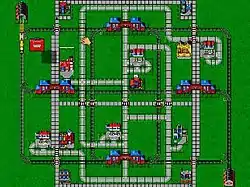Lego Loco
Lego Loco is a Lego-branded virtual world game for Microsoft Windows, released in November 1998.[2] It is a simple open-ended construction game with an emphasis on rail transport. The aim of the game is to construct a town in which Lego minifigures can live. This was the first game released by Lego Media, the publishing division of The Lego Group that was founded after the commercial success of Mindscape's Lego Island.
| Lego Loco | |
|---|---|
 | |
| Developer(s) | Intelligent Games |
| Publisher(s) | Lego Media |
| Director(s) | Kevin Shrapnell |
| Producer(s) | Matthew Stibbe / Dee Jarvis (Team Leader) |
| Programmer(s) |
|
| Artist(s) |
|
| Composer(s) | Richard Joseph |
| Platform(s) | Microsoft Windows |
| Release | 11 November 1998[1] |
| Genre(s) | Virtual world |
| Mode(s) | Single-player, multiplayer |
Gameplay

At the start of the game, the player is bestowed with a "Toy Box", from which they can select different parts from lists and place them directly into the space provided. They can place down roads, railway lines, stations, crossings, buildings, and scenery. To start the simulation, the player must close the Toy Box, and the town will come to life (though the player can open it again to make changes, save the town, or open a new one). After a while Lego figures will begin moving into the houses provided (if any), and the player can, like with ordinary figures, pick them up and place them elsewhere. This can affect the figure's mood, depending on where it's placed.
Using the train house (engine shed), the player can create trains to run on the railway lines. If a train has passenger carriages it will stop at any stations that have been placed alongside the track. The player can control the train's speed and direction and add a mail carriage to the train, thus enabling it to stop at post offices and carry postcards that have been created by the player. The train or trains can also go through tunnels that the player can place at the edge of the map, and some tunnels can be used to help exchange postcards with other players (provided a network has been set).
Reception
| Publication | Score |
|---|---|
| The Daily Telegraph | 4/5[3] |
Lego Loco was generally well received[4] with it having been awarded 2 noteworthy accolades: CODIE Software Publishers Association Excellence in Software Awards - Best New Strategy and Simulation Software; and PIN Quality Mark Gold Award - Parents Information Network.[4][5]
Aaron Curtiss from the Los Angeles Times said in his review that "Lego Loco is a mess. The intent was to give kids a virtual railroad to build and run. What they get is a game that made me want to tie myself to the tracks".[6]
References
- "Company.News". Intelligent Games. 24 November 1998. Archived from the original on 21 February 1999.
IG completed LEGO Loco ™ on schedule last week for LEGO Media International. It will be released on 11 November.
- "LEGO Media International Introduces Three New Software Titles" (Press release). Lego Media. 22 September 2018. Archived from the original on 7 October 2018 – via The Free Library.
LEGO Media International, a division of the LEGO Group, will release three new software titles for children this November. The three new products -- LEGO Creator(TM), LEGO Loco(TM) and LEGO Chess(TM) -- will extend the LEGO(R) values of quality, creativity and imagination into interactive software.
- Yelvelton, Martin (10 December 1998). "Lego Loco". The Daily Telegraph. p. 74. Archived from the original on 4 October 2023. Retrieved 4 October 2023 – via Newspapers.com.
- "Lego Loco Reviews, News, Descriptions, Walkthrough and System Requirements :: Game Database". SocksCap64. Retrieved 14 September 2023.
- "LEGO Loco - PC". Gamepressure.com. Retrieved 14 September 2023.
- Curtiss, Aaron (28 December 1998). "Where Fun Runs Into a Brick Wall". Los Angeles Times. Archived from the original on 4 October 2023. Retrieved 4 October 2023.